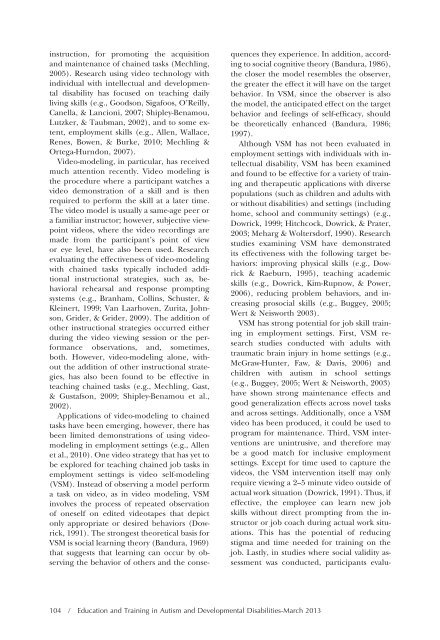etadd_48(1) - Division on Autism and Developmental Disabilities
etadd_48(1) - Division on Autism and Developmental Disabilities
etadd_48(1) - Division on Autism and Developmental Disabilities
Create successful ePaper yourself
Turn your PDF publications into a flip-book with our unique Google optimized e-Paper software.
instructi<strong>on</strong>, for promoting the acquisiti<strong>on</strong><br />
<strong>and</strong> maintenance of chained tasks (Mechling,<br />
2005). Research using video technology with<br />
individual with intellectual <strong>and</strong> developmental<br />
disability has focused <strong>on</strong> teaching daily<br />
living skills (e.g., Goods<strong>on</strong>, Sigafoos, O’Reilly,<br />
Canella, & Lanci<strong>on</strong>i, 2007; Shipley-Benamou,<br />
Lutzker, & Taubman, 2002), <strong>and</strong> to some extent,<br />
employment skills (e.g., Allen, Wallace,<br />
Renes, Bowen, & Burke, 2010; Mechling &<br />
Ortega-Hurnd<strong>on</strong>, 2007).<br />
Video-modeling, in particular, has received<br />
much attenti<strong>on</strong> recently. Video modeling is<br />
the procedure where a participant watches a<br />
video dem<strong>on</strong>strati<strong>on</strong> of a skill <strong>and</strong> is then<br />
required to perform the skill at a later time.<br />
The video model is usually a same-age peer or<br />
a familiar instructor; however, subjective viewpoint<br />
videos, where the video recordings are<br />
made from the participant’s point of view<br />
or eye level, have also been used. Research<br />
evaluating the effectiveness of video-modeling<br />
with chained tasks typically included additi<strong>on</strong>al<br />
instructi<strong>on</strong>al strategies, such as, behavioral<br />
rehearsal <strong>and</strong> resp<strong>on</strong>se prompting<br />
systems (e.g., Branham, Collins, Schuster, &<br />
Kleinert, 1999; Van Laarhoven, Zurita, Johns<strong>on</strong>,<br />
Grider, & Grider, 2009). The additi<strong>on</strong> of<br />
other instructi<strong>on</strong>al strategies occurred either<br />
during the video viewing sessi<strong>on</strong> or the performance<br />
observati<strong>on</strong>s, <strong>and</strong>, sometimes,<br />
both. However, video-modeling al<strong>on</strong>e, without<br />
the additi<strong>on</strong> of other instructi<strong>on</strong>al strategies,<br />
has also been found to be effective in<br />
teaching chained tasks (e.g., Mechling, Gast,<br />
& Gustafs<strong>on</strong>, 2009; Shipley-Benamou et al.,<br />
2002).<br />
Applicati<strong>on</strong>s of video-modeling to chained<br />
tasks have been emerging, however, there has<br />
been limited dem<strong>on</strong>strati<strong>on</strong>s of using videomodeling<br />
in employment settings (e.g., Allen<br />
et al., 2010). One video strategy that has yet to<br />
be explored for teaching chained job tasks in<br />
employment settings is video self-modeling<br />
(VSM). Instead of observing a model perform<br />
a task <strong>on</strong> video, as in video modeling, VSM<br />
involves the process of repeated observati<strong>on</strong><br />
of <strong>on</strong>eself <strong>on</strong> edited videotapes that depict<br />
<strong>on</strong>ly appropriate or desired behaviors (Dowrick,<br />
1991). The str<strong>on</strong>gest theoretical basis for<br />
VSM is social learning theory (B<strong>and</strong>ura, 1969)<br />
that suggests that learning can occur by observing<br />
the behavior of others <strong>and</strong> the c<strong>on</strong>se-<br />
quences they experience. In additi<strong>on</strong>, according<br />
to social cognitive theory (B<strong>and</strong>ura, 1986),<br />
the closer the model resembles the observer,<br />
the greater the effect it will have <strong>on</strong> the target<br />
behavior. In VSM, since the observer is also<br />
the model, the anticipated effect <strong>on</strong> the target<br />
behavior <strong>and</strong> feelings of self-efficacy, should<br />
be theoretically enhanced (B<strong>and</strong>ura, 1986;<br />
1997).<br />
Although VSM has not been evaluated in<br />
employment settings with individuals with intellectual<br />
disability, VSM has been examined<br />
<strong>and</strong> found to be effective for a variety of training<br />
<strong>and</strong> therapeutic applicati<strong>on</strong>s with diverse<br />
populati<strong>on</strong>s (such as children <strong>and</strong> adults with<br />
or without disabilities) <strong>and</strong> settings (including<br />
home, school <strong>and</strong> community settings) (e.g.,<br />
Dowrick, 1999; Hitchcock, Dowrick, & Prater,<br />
2003; Meharg & Woltersdorf, 1990). Research<br />
studies examining VSM have dem<strong>on</strong>strated<br />
its effectiveness with the following target behaviors:<br />
improving physical skills (e.g., Dowrick<br />
& Raeburn, 1995), teaching academic<br />
skills (e.g., Dowrick, Kim-Rupnow, & Power,<br />
2006), reducing problem behaviors, <strong>and</strong> increasing<br />
prosocial skills (e.g., Buggey, 2005;<br />
Wert & Neisworth 2003).<br />
VSM has str<strong>on</strong>g potential for job skill training<br />
in employment settings. First, VSM research<br />
studies c<strong>on</strong>ducted with adults with<br />
traumatic brain injury in home settings (e.g.,<br />
McGraw-Hunter, Faw, & Davis, 2006) <strong>and</strong><br />
children with autism in school settings<br />
(e.g., Buggey, 2005; Wert & Neisworth, 2003)<br />
have shown str<strong>on</strong>g maintenance effects <strong>and</strong><br />
good generalizati<strong>on</strong> effects across novel tasks<br />
<strong>and</strong> across settings. Additi<strong>on</strong>ally, <strong>on</strong>ce a VSM<br />
video has been produced, it could be used to<br />
program for maintenance. Third, VSM interventi<strong>on</strong>s<br />
are unintrusive, <strong>and</strong> therefore may<br />
be a good match for inclusive employment<br />
settings. Except for time used to capture the<br />
videos, the VSM interventi<strong>on</strong> itself may <strong>on</strong>ly<br />
require viewing a 2–5 minute video outside of<br />
actual work situati<strong>on</strong> (Dowrick, 1991). Thus, if<br />
effective, the employee can learn new job<br />
skills without direct prompting from the instructor<br />
or job coach during actual work situati<strong>on</strong>s.<br />
This has the potential of reducing<br />
stigma <strong>and</strong> time needed for training <strong>on</strong> the<br />
job. Lastly, in studies where social validity assessment<br />
was c<strong>on</strong>ducted, participants evalu-<br />
104 / Educati<strong>on</strong> <strong>and</strong> Training in <strong>Autism</strong> <strong>and</strong> <strong>Developmental</strong> <strong>Disabilities</strong>-March 2013
















